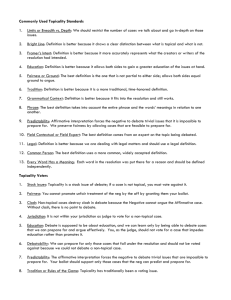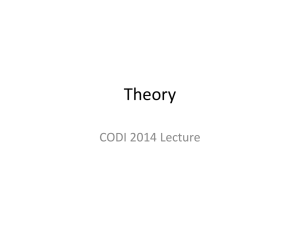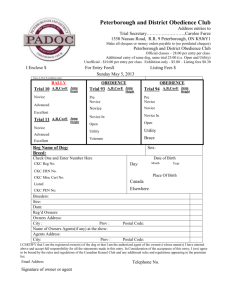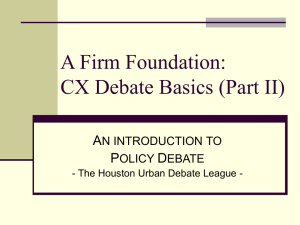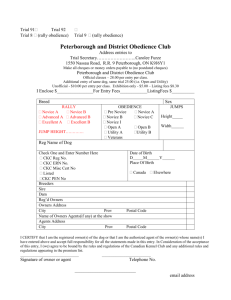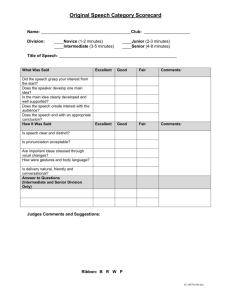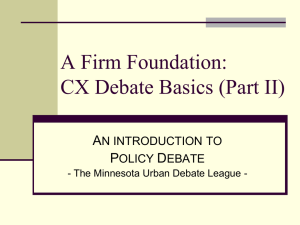Topicality
advertisement
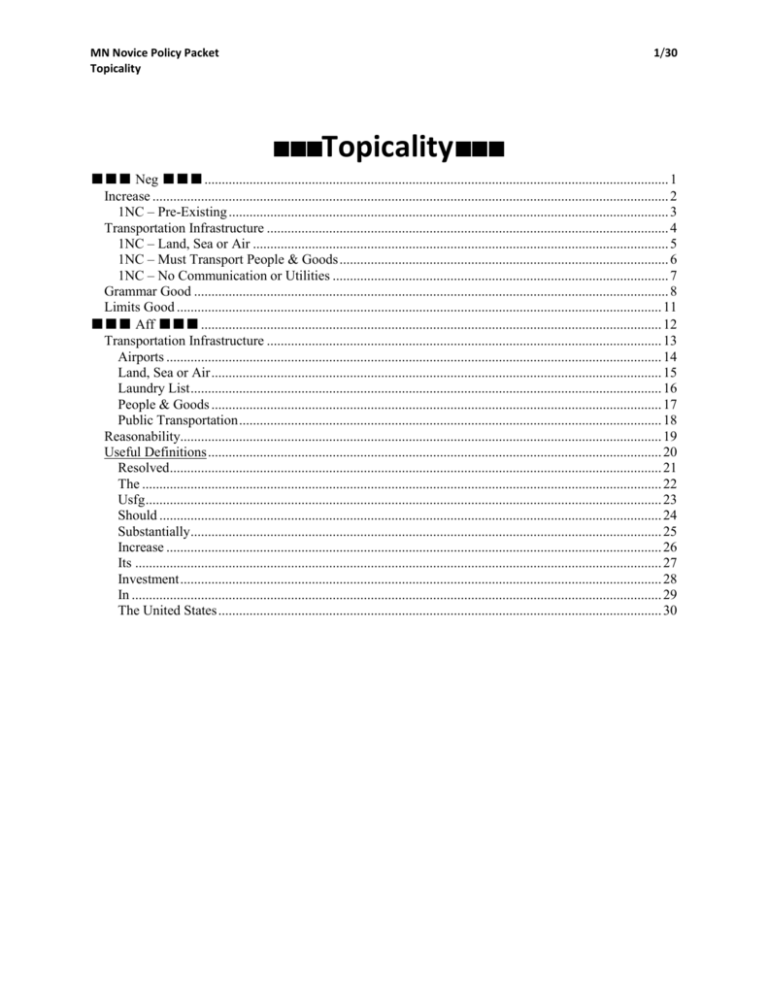
MN Novice Policy Packet Topicality 1/30 ■■■Topicality■■■ ■■■ Neg ■■■ ...................................................................................................................................... 1 Increase ..................................................................................................................................................... 2 1NC – Pre-Existing ............................................................................................................................... 3 Transportation Infrastructure .................................................................................................................... 4 1NC – Land, Sea or Air ........................................................................................................................ 5 1NC – Must Transport People & Goods ............................................................................................... 6 1NC – No Communication or Utilities ................................................................................................. 7 Grammar Good ......................................................................................................................................... 8 Limits Good ............................................................................................................................................ 11 ■■■ Aff ■■■ ..................................................................................................................................... 12 Transportation Infrastructure .................................................................................................................. 13 Airports ............................................................................................................................................... 14 Land, Sea or Air .................................................................................................................................. 15 Laundry List ........................................................................................................................................ 16 People & Goods .................................................................................................................................. 17 Public Transportation .......................................................................................................................... 18 Reasonability........................................................................................................................................... 19 Useful Definitions ................................................................................................................................... 20 Resolved.............................................................................................................................................. 21 The ...................................................................................................................................................... 22 Usfg ..................................................................................................................................................... 23 Should ................................................................................................................................................. 24 Substantially........................................................................................................................................ 25 Increase ............................................................................................................................................... 26 Its ........................................................................................................................................................ 27 Investment ........................................................................................................................................... 28 In ......................................................................................................................................................... 29 The United States ................................................................................................................................ 30 MN Novice Policy Packet Topicality 2/30 Increase MN Novice Policy Packet Topicality 3/30 1NC – Pre-Existing a. Interpretation – increase must apply to pre-existing investment Words & Phrases 60 http://www.samford.edu/Opening_Topic_Lecture_2007.ppt#18 “Increased,” as used in West’s Ann Cal Const art 12, 11, providing that the stock and bonded indebtedness of corporations shall not be increased without the consent of the person holding the larger amount of the stock , does not include or apply to the first creation of bonded indebtedness. To give it such a meaning would be to inject into the provision the word “create.” b. Prefer our interpretation 1. Predictable limits – we can’t predict new investments in new forms of transportation infrastructure 2. Neg ground – our interpretation is key to ensure generic DA links and counterplan ground c. Topicality is a jurisdictional voting issue MN Novice Policy Packet Topicality Transportation Infrastructure 4/30 MN Novice Policy Packet Topicality 5/30 1NC – Land, Sea or Air a. Interpretation – transportation infrastructure deals with the development or operation of a land, sea or air transport NZEEA 12 – New Zealand Engineering Excellence Awards (“CONDITIONS OF ENTRY AND JUDGING CRITERIA: AWARDS FOR PROJECTS AND PRODUCTS,” PDF) Transportation Infrastructure refers to recent activities associated with the development or operation of any form of land, sea or air transport infrastructure assets. Includes bridges, tunnels, rail, road, port, airport construction, transportation and traffic engineering. b. Prefer our interpretation 1. Predictable limits – we include only the most common forms of transportation infrastructure 2. Ground – our interpretation is key to generic links and core affirmatives c. Topicality is a jurisdictional voting issue MN Novice Policy Packet Topicality 6/30 1NC – Must Transport People & Goods a. Interpretation – transportation infrastructure must transport people and goods Orr and Keever 8 (Ryan J., executive director at the Collaboratory for Research on Global Projects at Stanford University, Gregory, California admitted attorney, January, “Enabling User-Fee Backed Transportation Finance in California,” PDF) Here transportation infrastructure is defined as “any fixed physical asset designed for transporting people and goods including highways, arterial streets, bridges, tunnels, and mass transportation systems.”1 An often overlooked aspect of transportation infrastructure, even of the most well constructed type, is that it is a consumable asset: it has a finite life, wears out with use, and needs periodic replacement. b. Prefer our interpretation 1. Predictable limits – we only include roads, bridges, tunnels and mass transportation systems 2. Neg ground – requiring people and goods ensures generic DA links c. Topicality is a jurisdictional voting issue MN Novice Policy Packet Topicality 7/30 1NC – No Communication or Utilities a. Interpretation – transportation infrastructure is distinct from communication and utilities IEDC 12 – International Economic Development Council (“Economic Development Reference Guide,” http://www.iedconline.org/?p=Guide_Infrastructure) Infrastructure encompasses existing transportation, communication and utility networks. Rebuilding the physical infrastructure of a community improves the local business climate and is critical to the redevelopment of distressed neighborhoods. Infrastructure gets people to their jobs and goods and services to their markets. Many distressed neighborhoods suffer from inadequate infrastructure, decreasing their access to economic opportunities and their ability to integrate into wider city, national, and international markets. Programs to build roads, provide water and waste removal, and offer telecommunications services all bestow substantial economic benefits such as job and business creation and retention to a community. Additionally, modernizing physical infrastructure can help improve the image of a distressed neighborhood. Transportation infrastructure includes: Roads Light transit rail networks, inter city, state passenger railways Airports Waterways and ports Bus services Communication infrastructure includes: Copper wire for telecommunications, installed by telecommunications companies High bandwidth and fiber optic cable capable of carrying voice, data and video streams Satellite communications and microwave antenna Mobile phone networks Local area networks (LAN) Utility infrastructure includes: Electric power Water and sewage treatment Natural gas lines b. Prefer our interpretation 1. Predictable limits – we exclude other forms of infrastructure investment 2. Ground – our interpretation is most precise, ensuring generic link ground c. Topicality is a jurisdictional voting issue MN Novice Policy Packet Topicality 8/30 Grammar Good Grammar outweighs – 1. Arguments in favor of contextual readings should privilege grammatical warrants – grammar IS the context of the resolution 2. Multiple interpretations are acceptable from a research perspective but only one can claim grammatical superiority MN Novice Policy Packet Topicality 9/30 3. Grammar is good – key to precise communication, discernment, and critical thinking – prioritize form over content Stanley Fish, dean of the College of Liberal Arts and Sciences at the University of Illinois at Chicago, June 21, 2002. “Say It Ain't So,” THE CHRONICLE, http://chronicle.com/article/Say-It-Ain-t-So/46137 Well, actually everyone knows what's going on. The art of speaking and writing precisely and with attention to grammatical form is more and more a lost one. Just listen to National Public Radio for 15 minutes or read a section of The New York Times and you will be able to start your own collection of howlers, from the (now ubiquitous) confusion of "disinterested" and "uninterested" (which sometimes takes the form of a parallel confusion of "disinvite" and "uninvite," the latter not an English verb form); to the disastrous and often comical substitution of "enervate" for "energize"; to the attribution of reticence to persons who are merely reluctant; to participles with no subjects or too many; to errors of pomposity ("between you and I," dubbed by a former colleague the "Cornell nominative"); to pronouns without referents or as many referents as there are nouns in the previous five sentences; to singular subjects with plural verbs (and the reverse); to dependent clauses attached to nothing; to mismatched tenses attached to the same action; to logical redundancies like, "The reason is because ..." ( I'm afraid I've been guilty of that one myself); not to mention inelegant repetitions and errors of diction made by persons who seem to be writing a language they first encountered yesterday. What has brought us to this sorry pass? Basically, two things. First the belief, devoutly held and endlessly rehearsed, that the purpose of writing is self-expression. The convenience of this belief, for those who profess it, is that they need never accept correction; for if it is their precious little selves they are expressing, the language of expression is answerable only to the internal judgment of those same selves, and any challenge from the outside can be met simply by saying, (as students often do) "I know what I mean," or, more precisely, "I know what I mean." Students who say and believe this will never confront an important truth: Language has its own structure (not unchanging, to be sure, but fixed enough at any one moment to serve as both a constraint and a resource). If you do not submit yourself to the conventional meanings of words and to the grammatical forms that specify the relationships between the objects words refer to, the prose you produce will say something -- language, not you or I, means -- but it will not say what you wanted to say. That's only because your readers will not be inside your head where they might ask the self-seeking expression what it had in mind, but will instead be on the outside processing the formal patterns of your written language and reaching the conclusions dictated and generated by those patterns. In fact, however, what I've just said is a bit misleading because it suggests that fully formed thoughts exist in some inner mental space and manage to make it into the outside world when they are clothed in the proper syntactical and lexical forms. But as everyone used to know before the cult of self-expression triumphed, the ability even to have certain kinds of thoughts depends on the prior ability to produce (and comprehend) certain kinds of sentences. People don't think naturally in the future perfect or in parallel constructions or in the subjunctive mood; rather these grammatical alternatives are learned, and learned with them are the ways of thinking they make possible -- relating to one another on a time-line events or states of being that have not yet happened; lining up persons, objects, and actions in relationships of similarity and opposition; reasoning from contrary-to-fact assertions to assertions about what was or could be done in the past, present, or future. These are complex mental actions, and students will be able to perform them only if their minds are stocked with the right grammatical furniture, with forms that have no specific content but make possible the organization of any content into temporal/spatial arrangements that suggest and make available modes of action in the world. The organization of the world in ways that expand the possibilities of thought and action -- that, not self-expression, is the purpose of writing, and it is preeminently a social purpose. That is, it is a purpose not pursued alone but in conjunction with others to whom one writes (in speeches, essays, letters, memos, directives, proclamations, editorials, books) with the intention of imparting information, or clarifying issues, or establishing truths or bringing about changes or rousing armies or quieting conflicts, or any of the other ends one might work for in the public arena. Writing then is, by and large, an act either of communication or persuasion, and to engage in it successfully, you have to do more than have something to say; you must be prepared to back it up, supply evidence, respond to objections, expose contradictions, parse the arguments of the opposition and so on. You must conceive yourself not as a lone voice singing in the shower, but as a participant in the multiple dialogues that are the vehicles of discursive and political life. But you will not be able to participate effectively if you are content merely to have expressed your opinion. And this brings me to the second reason so many of our students are incapable of writing intelligible sentences or of linking one bad sentence to another in something that approximates an argument. They have been allowed to believe that their opinions -- formed by nothing, supported by even less -- are interesting. The belief that what you're supposed to do is express yourself goes hand in hand with the belief that whatever you happen to express is valuable and if you believe both these things you will not believe that there is any reason to worry about subject-verb agreement or pronouns without nouns or missing transitions or anything else. In response to any question you just say the first thing that comes into your head, and in response to any challenge you just say, "That's my opinion" or "That's what I think," or "My view is as good as yours." No sentiments are more subversive of the possibility of productive classroom activity, and the instructor who hears them coming from the mouths of his or her students should immediately tell them, "Check your opinions, your ideas, your views at the door; they are not fungible currency here." This announcement, which will, at the very least, deliver a salutary shock ("I can't believe she said that"), might possibly open up a space in which writing is taken seriously because it will have identified (by an act of elimination) the true nature of academic work, which is not the work of caressing the self and its effusions, but the work of applying the techniques of reflection, analysis, and critique to matters of general (not personal) concern. But of course no action taken by a single instructor is likely to change very much in the absence of structural changes in the way writing and argument are taught. And here is where the administration comes in. Every dean should forthwith insist that all composition courses teach grammar and rhetoric and nothing else. No composition course should have a theme, especially not one the instructor is interested in. Ideas should be introduced not for their own sake, but for the sake of the syntactical and rhetorical points they help illustrate, and once they serve this purpose, they should be sent away. Content should be avoided like the plague it is, except for the deep and inexhaustible MN Novice Policy Packet Topicality 10/30 content that will reveal itself once the dynamics of language are regarded not as secondary, mechanical aids to thought, but as thought itself. MN Novice Policy Packet Topicality 11/30 Limits Good Limits outweigh – key to effective education and participation at all levels of the activity Rowland 84 (Robert C., Baylor U., “Topic Selection in Debate”, American Forensics in Perspective. Ed. Parson, p. 53-4) The first major problem identified by the work group as relating to topic selection is the decline in participation in the National Debate Tournament (NDT) policy debate. As Boman notes: There is a growing dissatisfaction with academic debate that utilizes a policy proposition. Programs which are oriented toward debating the national policy debate proposition, so-called “NDT” programs, are diminishing both in scope and size. This decline in policy debate is tied, many in the work group believe, to excessively broad topics. The most obvious characteristic of some recent policy debate topics is extreme breadth. A resolution calling for regulation of land use literally and figuratively covers a lot of ground. National debate topics have not always been so broad. Before the late 1960s the topic often specified a particular policy change. The move from narrow to broad topics has had, according to some, the effect of limiting the number of students who participate in policy debate. First, the breadth of topics has all but destroyed novice debate. Paul Gaske argues that because the stock issues of policy debate are clearly defined, it is superior to value debate as a means of introducing students to the debate process. Despite this advantage of policy debate, Gaske believes that NDT debate is not the best vehicle for teaching beginners. The problem is that broad topics terrify novice debaters, especially those who lack high school debate experience. They are unable to cope with the breath of the topic and experience “negophobia,” the fear of debating negative. As a consequence, the educational advantages associated with teaching novice through policy debate are lost: “Yet all of these benefits fly out the window as rookies in their formative stage quickly experience humiliation at being caught without evidence or substantive awareness of the issues that confront them at a tournament.” The ultimate result is that fewer novices participate in NDT, thus lessening the educational value of the activity and limiting the number of debaters who eventually participate in more advanced divisions of policy debate. In addition to noting the effect on novices, participants argued that broad topics also discourage experienced debaters from continued participation in policy debate. Here, the claim is that it takes so much time and effort to be competitive on a broad topic that students who are concerned with doing more than just debate are forced out of the activity. Gaske notes, that “broad topics discourage participation because of insufficient time to do requisite research.” The final effect may be that entire programs wither cease functioning or shift to value debate as a way to avoid unreasonable research burdens. Boman supports this point: “It is this expanding necessity of evidence, and thereby research, which has created a competitive imbalance between institutions that participate in academic debate.” In this view, it is the competitive imbalance resulting from the use of broad topics that has led some small schools to cancel their programs. MN Novice Policy Packet Topicality 12/30 ■■■ Affirmative ■■■ MN Novice Policy Packet Topicality Transportation Infrastructure 13/30 MN Novice Policy Packet Topicality 14/30 Airports Transportation infrastructure includes airports – their interpretation doesn’t assume the phrase’s evolving nature GIR 3 – The Global Infrastructure Report (September, http://www.siteselection.com/issues/2003/sep/p524/) Central to any region's success as an economic center is its transportation and logistics infrastructure. This used to mean having rail, highway, air and sea access – even two or three of these could support key industries. But some areas are seeking to distance themselves from competitive locations and are re-evaluating the definition of transportation infrastructure. In the case of airports, an increasing number of regions are developing not just new terminals and runways, but integrated, multimodal transportation hubs designed to deliver passenger and cargo services as well as distribution and logistics solutions to industries for decades to come. MN Novice Policy Packet Topicality 15/30 Land, Sea or Air Transportation infrastructure deals with the development or operation of land, sea or air transport NZEEA 12 – New Zealand Engineering Excellence Awards (“CONDITIONS OF ENTRY AND JUDGING CRITERIA: AWARDS FOR PROJECTS AND PRODUCTS,” PDF) Transportation Infrastructure refers to recent activities associated with the development or operation of any form of land, sea or air transport infrastructure assets. Includes bridges, tunnels, rail, road, port, airport construction, transportation and traffic engineering. MN Novice Policy Packet Topicality 16/30 Laundry List Transportation infrastructure includes roads, railways, airports, waterways, seaports and bus services IEDC 12 – International Economic Development Council (“Economic Development Reference Guide,” http://www.iedconline.org/?p=Guide_Infrastructure) Infrastructure encompasses existing transportation, communication and utility networks. Rebuilding the physical infrastructure of a community improves the local business climate and is critical to the redevelopment of distressed neighborhoods. Infrastructure gets people to their jobs and goods and services to their markets. Many distressed neighborhoods suffer from inadequate infrastructure, decreasing their access to economic opportunities and their ability to integrate into wider city, national, and international markets. Programs to build roads, provide water and waste removal, and offer telecommunications services all bestow substantial economic benefits such as job and business creation and retention to a community. Additionally, modernizing physical infrastructure can help improve the image of a distressed neighborhood. Transportation infrastructure includes: Roads Light transit rail networks, inter city, state passenger railways Airports Waterways and ports Bus services Communication infrastructure includes: Copper wire for telecommunications, installed by telecommunications companies High bandwidth and fiber optic cable capable of carrying voice, data and video streams Satellite communications and microwave antenna Mobile phone networks Local area networks (LAN) Utility infrastructure includes: Electric power Water and sewage treatment Natural gas lines Transportation infrastructure includes roads, railways, waterways, seaports, mass transit systems and airports Geocom 12 – leading supplier of geographic information systems (“Public Infrastructure,” geocom.ch/sites/default/files/ma03e_publicinfrastructure_0.pdf) Transportation infrastructure includes road and highway networks, railways, waterways and seaports, mass transit systems and airports. All of these multifaceted infrastructures require a high level of administration to operate successfully in the private sector. MN Novice Policy Packet Topicality 17/30 People & Goods Transportation infrastructure must transport people and goods Orr and Keever 8 (Ryan J., executive director at the Collaboratory for Research on Global Projects at Stanford University, Gregory, California admitted attorney, January, “Enabling User-Fee Backed Transportation Finance in California,” PDF) Here transportation infrastructure is defined as “any fixed physical asset designed for transporting people and goods including highways, arterial streets, bridges, tunnels, and mass transportation systems.”1 An often overlooked aspect of transportation infrastructure, even of the most well constructed type, is that it is a consumable asset: it has a finite life, wears out with use, and needs periodic replacement. MN Novice Policy Packet Topicality 18/30 Public Transportation Transportation infrastructure includes public transportation Cordingly 12 – Huffington Post (Christopher, 05/09, “Healthy Roads, Healthy Schools: A Look Into the Effects of Transportation Infrastructure,” http://www.huffingtonpost.com/christopher-cordingley/healthy-roads-healthy-schools_b_1499695.html) Transportation infrastructure is defined in this study, but is not limited to, easily accessible public transportation, whereas job productivity is measured in use of sick leave. The study looks at whether increased investments in transportation infrastructure in rural and urban environments gives people greater access to local health care. Due to an increase in accessibility, it is proposed that low graduation rates can be effectively treated by addressing health concerns early before they progress to more serious conditions that will cause adults and children to miss more work and school. The study examines how better access to health care increases hire-ability, job productivity, and graduation rates. Job productivity and graduation rates are analyzed in other countries in relation to these countries' connections to health care access via public transportation and road development. It is predicted that there is a positive correlation between the amount of transportation funding and graduation rates/job productivity. MN Novice Policy Packet Topicality 19/30 Reasonability Default to reasonability on this topic – the definition of transportation infrastructure is evolving GIR 3 – The Global Infrastructure Report (September, http://www.siteselection.com/issues/2003/sep/p524/) Central to any region's success as an economic center is its transportation and logistics infrastructure. This used to mean having rail, highway, air and sea access – even two or three of these could support key industries. But some areas are seeking to distance themselves from competitive locations and are re-evaluating the definition of transportation infrastructure. MN Novice Policy Packet Topicality 20/30 Useful Definitions MN Novice Policy Packet Topicality 21/30 Resolved Resolved just means a decision about the topic is made http://dictionary.reference.com/browse/resolved re·solve [ri-zolv] Show IPA verb, -solved, -solv·ing, noun verb (used with object) 1. to come to a definite or earnest decision about; determine (to do something): I have resolved that I shall live to the full. MN Novice Policy Packet Topicality 22/30 The The simply marks a noun http://dictionary.reference.com/browse/the the1 [stressed thee; unstressed before a consonant thuh; unstressed before a vowel thee] Show IPA definite article (used to mark a noun as indicating the best-known, most approved, most important, most satisfying, etc.): the skiing center of the U.S.; If you're going to work hard, now is the time. 5. (used to mark a noun as being used generically): The dog is a quadruped. MN Novice Policy Packet Topicality 23/30 Usfg The Usfg is the government in Washington D.C. Encarta 2k – Microsoft Encarta Online Encyclopedia (http://encarta.msn.com) “The federal government of the United States is centered in Washington DC.” MN Novice Policy Packet Topicality 24/30 Should Should means consider an action http://dictionary.reference.com/browse/should should (ʃʊd) — vb See also shall the past tense of shall : used as an auxiliary verb to indicate that an action is considered by the speaker to be obligatory ( you should go ) or to form the subjunctive mood with I or we ( I should like to see you; if I should be late, go without me ) MN Novice Policy Packet Topicality 25/30 Substantially Substantial means in the main – most common Cambridge Advanced Learner's Dictionary, 2004 http://dictionary.cambridge.org/define.asp?key=79480&dict=CALD substantial (GENERAL) [Show phonetics] adjective [before noun] FORMAL relating to the main or most important things being considered: The committee were in substantial agreement (= agreed about most of the things discussed). MN Novice Policy Packet Topicality 26/30 Increase Increase can go from zero to one Based on WordNet 3.0, Farlex clipart collection. © 2003-2008 Princeton University, Farlex Inc. http://www.thefreedictionary.com/increase 3. increase - a process of becoming larger or longer or more numerous or more important; "the increase in unemployment"; "the growth of population" increment, growth physical process, process - a sustained phenomenon or one marked by gradual changes through a series of states; "events now in process"; "the process of calcification begins later for boys than for girls" accession - a process of increasing by addition (as to a collection or group); "the art collection grew through accession" accretion, accumulation - an increase by natural growth or addition accretion - (geology) an increase in land resulting from alluvial deposits or waterborne sediment accretion - (biology) growth by addition as by the adhesion of parts or particles accretion - (astronomy) the formation of a celestial object by the effect of gravity pulling together surrounding objects and gases multiplication - a multiplicative increase; "repeated copying leads to a multiplication of errors"; "this multiplication of cells is a natural correlate of growth" population growth - increase in the number of people who inhabit a territory or state proliferation - a rapid increase in number (especially a rapid increase in the number of deadly weapons); "the proliferation of nuclear weapons" pullulation - a rapid and abundant increase relaxation - (physiology) the gradual lengthening of inactive muscle or muscle fibers widening, broadening - an increase in width decrease, decrement - a process of becoming smaller or shorter 4. increase - the amount by which something increases; "they proposed an increase of 15 percent in the fare" increment amount - the relative magnitude of something with reference to a criterion; "an adequate amount of food for four people" amplification, gain - the amount of increase in signal power or voltage or current expressed as the ratio of output to input fare increase - increase in the sum charged for riding in a public conveyance price increase - increase in price raise, salary increase, wage hike, wage increase, hike, rise - the amount a salary is increased; "he got a 3% raise"; "he got a wage hike" cost increase, hike, boost, rise - an increase in cost; "they asked for a 10% rise in rates" supplementation, supplement - a quantity added (e.g. to make up for a deficiency) tax boost, tax hike, tax-increase - the amount by which taxes are increased; "a tax increase of 15 percent" up-tick - a small increase; "the up-tick in terrorist activity" decrement, decrease - the amount by which something decreases 5. increase - the act of increasing something; "he gave me an increase in salary" step-up change of magnitude - the act of changing the amount or size of something addition - the act of adding one thing to another; "the addition of flowers created a pleasing effect"; "the addition of a leap day every four years" advance, rise - increase in price or value; "the news caused a general advance on the stock market" appreciation - an increase in price or value; "an appreciation of 30% in the value of real estate" surge, upsurge - a sudden or abrupt strong increase; "stimulated a surge of speculation"; "an upsurge of emotion"; "an upsurge in violent crime" augmentation - the act of augmenting amplification - (electronics) the act of increasing voltage or power or current enlargement, expansion - the act of increasing (something) in size or volume or quantity or scope escalation - an increase to counteract a perceived discrepancy; "higher wages caused an escalation of prices"; "there was a gradual escalation of hostilities" maximation, maximisation, maximization - the act of raising to the highest possible point or condition or position exaggeration - the act of making something more noticeable than usual; "the dance involved a deliberate exaggeration of his awkwardness" expanding upon, expansion - adding information or detail accrual, accruement, accumulation - the act of accumulating inclusion - the act of including aggrandisement, aggrandizement, elevation - the act of increasing the wealth or prestige or power or scope of something; "the aggrandizement of the king"; "his elevation to cardinal" strengthening - the act of increasing the strength of something intensification - action that makes something stronger or more extreme intensification - the act of increasing the contrast of (a photographic film) split up, stock split, split - an increase in the number of outstanding shares of a corporation without changing the shareholders' equity; "they announced a two-for-one split of the common stock" reduction, step-down, diminution, decrease - the act of decreasing or reducing something 1. increase - become bigger or greater in amount; "The amount of work increased" MN Novice Policy Packet Topicality 27/30 Its Its must refer to the United States’ approach to investment for the resolution to be grammatical Manderino 73 Justice for the Supreme Court of Pennsylvania, Sigal, Appellant, v. Manufacturers Light and Heat Co., No. 26, Jan. T., 1972, Supreme Court of Pennsylvania, 450 Pa. 228; 299 A.2d 646; 1973 Pa. LEXIS 600; 44 Oil & Gas Rep. 214, lexis On its face, the written instrument granting easement rights in this case is ambiguous. The same sentence which refers to the right to lay a 14 makes no sense because the only writing is additionally ambiguous because other key words which are "also may change the size of its pipes" are dangling in that the possessive pronoun "its" before the word "pipes" does not have any subject preceding, to which the possessive pronoun refers. The dangling phrase is the beginning of a sentence, the first word of which inch pipeline (singular) has a later reference to "said lines" (plural). The use of the plural "lines" previous reference has been to a "line" (singular). The does not begin with a capital letter as is customary in normal English [***10] usage. Immediately preceding the "sentence" which does not begin with a capital letter, there appears a dangling [*236] semicolon which makes no sense at the beginning of a sentence and can deviations from accepted grammatical usage make difficult, if not impossible, a clear understanding of the words used or the intention of the parties. This is particularly true concerning the meaning of a disputed phrase in the instrument which states that the grantee hardly relate to the preceding sentence which is already properly punctuated by a closing period. The above is to pay damages from ". . . the relaying, maintaining and operating said pipeline. . . ." The instrument is ambiguous as to what the words ". . . relaying . . . said pipeline . . ." were intended to mean . Its means belonging to something previously mentioned Cambridge Dictionary ( “Its”, http://dictionary.cambridge.org/dictionary/british/its) Definition belonging to or relating to something that has already been mentioned The dog hurt its paw. Their house has its own swimming pool. The company increased its profits. I prefer the second option - its advantages are simplicity and cheapness. Its denotes possession Glossary of English Grammar Terms, 2005 (http://www.usingenglish.com/glossary/possessive-pronoun.html) Mine, yours, his, hers, its, ours, theirs are the possessive pronouns used to substitute a noun and to show possession or ownership. EG. This is your disk and that's mine. (Mine substitutes the word disk and shows that it belongs to me.) Possessive pronouns are words of exclusion Frey 28 (Judge for the Supreme Court of Missouri, Supreme Court of Missouri 320 Mo. 1058; 10 S.W.2d 47; 1928 Mo. LEXIS 834, lexis) In support of this contention appellant again argues that when any ambiguity exists in a will it is the duty of the court to construe the will under guidance of the presumption that the testatrix intended her property to go to her next of kin, unless there is a strong intention to the contrary. Again we say, there is intrinsic proof of a [*1074] strong intention to the contrary. In the first place, testatrix only named two of her blood relatives in the will and had she desired [***37] them to take the residuary estate she doubtless would have mentioned them by name in the residuary clause. In the second place, if she used the word "heirs" in the sense of blood relatives she certainly would have dispelled all ambiguity by stating whose blood relatives were intended. Not only had [**53] she taken pains in the will to identify her own two blood relatives but she had also identified certain blood relatives of her deceased husband. Had it been her intention to vest the residuary estate in her blood relatives solely, she would certainly have used the possessive pronoun "my" instead of the indefinite article "the" in the clause, "the above heirs." MN Novice Policy Packet Topicality 28/30 Investment Investment refers to money or capital http://dictionary.reference.com/browse/investment in·vest·ment [in-vest-muhnt] Show IPA noun 1. the investing of money or capital in order to gain profitable returns, as interest, income, or appreciation in value. MN Novice Policy Packet Topicality 29/30 In In means 'in the bounds of' American Heritage Dictionary 6 prep. Within the limits, bounds, or area of: was hit in the face; born in the spring; a chair in the garden. MN Novice Policy Packet Topicality 30/30 The United States The United States refers to the 50 states and Washington D.C. http://dictionary.reference.com/browse/united+states?s=t United States noun a republic in the N Western Hemisphere comprising 48 conterminous states, the District of Columbia, and Alaska in North America, and Hawaii in the N Pacific. 267,954,767; conterminous United States, 3,022,387 sq. mi. (7,827,982 sq. km); with Alaska and Hawaii, 3,615,122 sq. mi. (9,363,166 sq. km). Capital: Washington, D.C. Abbreviation: U.S., US Also called United States of America, America.
